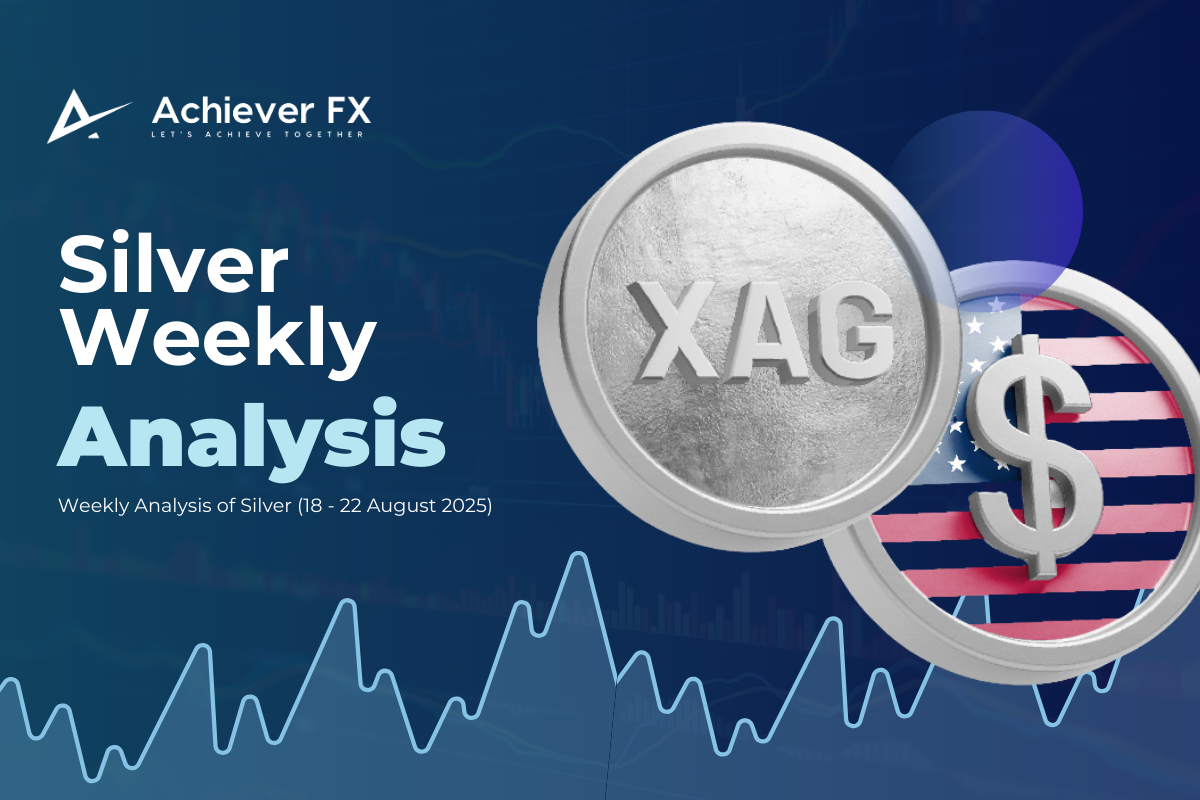Analysis of Silver 18-22 August 2025
Price Movements :-
As of August 19, 2025, silver was trading at $37.39 per troy ounce, down 1.67% from the previous day, reflecting short-term volatility. Over the past month, silver prices have declined by 3.94%, yet they remain 26.98% higher than a year ago, indicating a strong yearly uptrend despite recent pullbacks. The week prior to August 19 saw silver fluctuate, with prices briefly testing resistance near $38.50 but failing to break through, as noted in technical analyses.
- Weekly Trend (Mid-August): Silver has shown a pattern of testing higher resistance levels (e.g., $38.50) but has faced downward pressure, likely due to profit-taking and a strengthening U.S. dollar. The Relative Strength Index (RSI) on daily charts has signaled overbought conditions, suggesting a potential short-term consolidation or pullback, though the broader weekly RSI remains neutral, supporting an intact uptrend.
Key Drivers of Silver Prices:-
Silver’s price movements are influenced by its dual role as both an industrial metal and a safe-haven asset. Here are the primary factors at play:
- Safe-Haven Demand:
- Geopolitical tensions, including ongoing conflicts in the Middle East and between Russia and Ukraine, have bolstered silver’s appeal as a safe-haven asset. Economic uncertainties, such as U.S. tariff policies under President Trump, have fueled short covering and deliveries into CME warehouses since late 2024, supporting price recovery.
- However, silver’s safe-haven status is less pronounced than gold’s, and its industrial linkage makes it more sensitive to economic downturns. A potential recession could temporarily depress prices, though recovery is expected to be swift.
- Geopolitical tensions, including ongoing conflicts in the Middle East and between Russia and Ukraine, have bolstered silver’s appeal as a safe-haven asset. Economic uncertainties, such as U.S. tariff policies under President Trump, have fueled short covering and deliveries into CME warehouses since late 2024, supporting price recovery.
- Supply Constraints:
- The silver market is projected to face a significant deficit in 2025, with demand outpacing supply for the fifth consecutive year. Total silver supply has declined from 1.07 billion ounces in 2010 to an estimated 1.03 billion in 2024, while 2024 consumption reached 1.21 billion ounces, creating a 182-million-ounce deficit.
- Geopolitical issues in major silver-producing countries like Russia and Mexico (21% of global production) and environmental scrutiny on mining operations could further tighten supply, potentially driving prices higher.
- The silver market is projected to face a significant deficit in 2025, with demand outpacing supply for the fifth consecutive year. Total silver supply has declined from 1.07 billion ounces in 2010 to an estimated 1.03 billion in 2024, while 2024 consumption reached 1.21 billion ounces, creating a 182-million-ounce deficit.
- Monetary Policy and Inflation:
- Expectations of Federal Reserve rate cuts in 2025 reduce the opportunity cost of holding non-yielding assets like silver, making it more attractive. Inflation, reported at 2.7% at the end of 2024, continues to erode purchasing power, pushing investors toward silver as a hedge.
- A weakening U.S. dollar, anticipated in the latter half of 2025, could further support silver prices, as it becomes cheaper for international buyers.
- Expectations of Federal Reserve rate cuts in 2025 reduce the opportunity cost of holding non-yielding assets like silver, making it more attractive. Inflation, reported at 2.7% at the end of 2024, continues to erode purchasing power, pushing investors toward silver as a hedge.
- Gold-Silver Ratio:
- The gold-to-silver ratio, currently in the 75-95 range, suggests silver is undervalued relative to gold. A narrowing ratio (e.g., to 30-40) could propel silver prices significantly higher, potentially toward $100 per ounce in the coming years, as some analysts suggest.
Weekly Technical Outlook
- Support and Resistance: Key support levels are at $32.50 and $31.20, which have held as previous resistance zones turned support. Resistance is near $38.50, with a break above potentially targeting $40 by mid-2025.
- Indicators: The RSI on daily charts indicates overbought conditions, suggesting a possible pullback to the $36-$37 range in the near term. However, the weekly RSI supports a continued bullish trend, reinforced by silver trading above its 50-day Exponential Moving Average (EMA50).
- Chart Patterns: A bullish cup-and-handle formation on the 50-year silver chart signals a long-term breakout potential, with prices needing to hold above $30 to sustain momentum toward all-time highs ($49.55 in 2011).
Short-Term Forecast (Next Week):-
For the week following August 20, 2025, silver prices are likely to remain volatile within the $36-$38 range. A break above $38.50 could signal a push toward $40, driven by sustained industrial demand and safe-haven buying amid geopolitical uncertainties. Conversely, a stronger U.S. dollar or profit-taking could push prices toward support at $36 or lower. Investors should monitor:
- Federal Reserve Signals: Any hints of further rate cuts at the upcoming Fed meeting could bolster silver.
- Geopolitical Developments: Escalations in the Middle East or U.S. tariff announcements could drive safe-haven demand.
- Industrial Data: Updates on solar or automotive sector demand could influence price direction.
- Support and Resistance: Key support levels are at $32.50 and $31.20, which have held as previous resistance zones turned support. Resistance is near $38.50, with a break above potentially targeting $40 by mid-2025.
- The gold-to-silver ratio, currently in the 75-95 range, suggests silver is undervalued relative to gold. A narrowing ratio (e.g., to 30-40) could propel silver prices significantly higher, potentially toward $100 per ounce in the coming years, as some analysts suggest.
Conclusion:-
Silver’s weekly performance in mid-August 2025 reflects a bullish trend tempered by short-term volatility. Prices are supported by strong industrial demand, supply deficits, and safe-haven buying, but risks like a stronger dollar or economic slowdown could cause pullbacks. For holding silver bullion, a balanced approach—selling some now if liquidity is needed and retaining the rest for potential gains—makes sense given the optimistic 2025 forecasts. Stay informed on Fed policy, geopolitical events, and industrial demand trends to time your decisions effectively.
Note: Always conduct your own research, as market conditions can change rapidly. Technical ratings and sentiment are based on current data and may not reflect future movements.
- Safe-Haven Demand:








